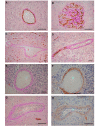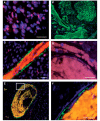A new alternative mechanism in glioblastoma vascularization: tubular vasculogenic mimicry
- PMID: 20375132
- PMCID: PMC4861203
- DOI: 10.1093/brain/awq044
A new alternative mechanism in glioblastoma vascularization: tubular vasculogenic mimicry
Abstract
Glioblastoma is one of the most angiogenic human tumours and endothelial proliferation is a hallmark of the disease. A better understanding of glioblastoma vasculature is needed to optimize anti-angiogenic therapy that has shown a high but transient efficacy. We analysed human glioblastoma tissues and found non-endothelial cell-lined blood vessels that were formed by tumour cells (vasculogenic mimicry of the tubular type). We hypothesized that CD133+ glioblastoma cells presenting stem-cell properties may express pro-vascular molecules allowing them to form blood vessels de novo. We demonstrated in vitro that glioblastoma stem-like cells were capable of vasculogenesis and endothelium-associated genes expression. Moreover, a fraction of these glioblastoma stem-like cells could transdifferentiate into vascular smooth muscle-like cells. We describe here a new mechanism of alternative glioblastoma vascularization and open a new perspective for the antivascular treatment strategy.
Figures




Comment in
-
Angiogenesis in glioblastoma: just another moving target?Brain. 2010 Apr;133(Pt 4):955-6. doi: 10.1093/brain/awq063. Epub 2010 Mar 30. Brain. 2010. PMID: 20354001 Review. No abstract available.
References
-
- Ausprunk DH, Folkman J. Migration and proliferation of endothelial cells in preformed and newly formed blood vessels during tumor angiogenesis. Microvasc Res. 1977;14:53–65. - PubMed
-
- Bonnet D, Dick JE. Human acute myeloid leukemia is organized as a hierarchy that originates from a primitive hematopoietic cell. Nat Med. 1997;3:730–7. - PubMed
-
- Culley B, Murphy J, Babaie J, Nguyen D, Pagel A, Rousselle P, et al. Laminin-5 promotes neurite outgrowth from central and peripheral chick embryonic neurons. Neurosci Lett. 2001;301:83–6. - PubMed
Publication types
MeSH terms
Grants and funding
LinkOut - more resources
Full Text Sources
Other Literature Sources
Research Materials

